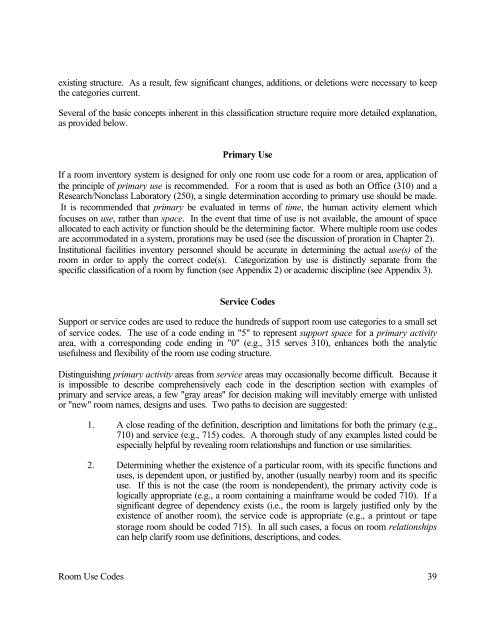Room Use Codes & Definitions
Room Use Codes & Definitions
Room Use Codes & Definitions
You also want an ePaper? Increase the reach of your titles
YUMPU automatically turns print PDFs into web optimized ePapers that Google loves.
existing structure. As a result, few significant changes, additions, or deletions were necessary to keepthe categories current.Several of the basic concepts inherent in this classification structure require more detailed explanation,as provided below.Primary <strong>Use</strong>If a room inventory system is designed for only one room use code for a room or area, application ofthe principle of primary use is recommended. For a room that is used as both an Office (310) and aResearch/Nonclass Laboratory (250), a single determination according to primary use should be made.It is recommended that primary be evaluated in terms of time, the human activity element whichfocuses on use, rather than space. In the event that time of use is not available, the amount of spaceallocated to each activity or function should be the determining factor. Where multiple room use codesare accommodated in a system, prorations may be used (see the discussion of proration in Chapter 2).Institutional facilities inventory personnel should be accurate in determining the actual use(s) of theroom in order to apply the correct code(s). Categorization by use is distinctly separate from thespecific classification of a room by function (see Appendix 2) or academic discipline (see Appendix 3).Service <strong>Codes</strong>Support or service codes are used to reduce the hundreds of support room use categories to a small setof service codes. The use of a code ending in "5" to represent support space for a primary activityarea, with a corresponding code ending in "0" (e.g., 315 serves 310), enhances both the analyticusefulness and flexibility of the room use coding structure.Distinguishing primary activity areas from service areas may occasionally become difficult. Because itis impossible to describe comprehensively each code in the description section with examples ofprimary and service areas, a few "gray areas" for decision making will inevitably emerge with unlistedor "new" room names, designs and uses. Two paths to decision are suggested:1. A close reading of the definition, description and limitations for both the primary (e.g.,710) and service (e.g., 715) codes. A thorough study of any examples listed could beespecially helpful by revealing room relationships and function or use similarities.2. Determining whether the existence of a particular room, with its specific functions anduses, is dependent upon, or justified by, another (usually nearby) room and its specificuse. If this is not the case (the room is nondependent), the primary activity code islogically appropriate (e.g., a room containing a mainframe would be coded 710). If asignificant degree of dependency exists (i.e., the room is largely justified only by theexistence of another room), the service code is appropriate (e.g., a printout or tapestorage room should be coded 715). In all such cases, a focus on room relationshipscan help clarify room use definitions, descriptions, and codes.<strong>Room</strong> <strong>Use</strong> <strong>Codes</strong> 39
















